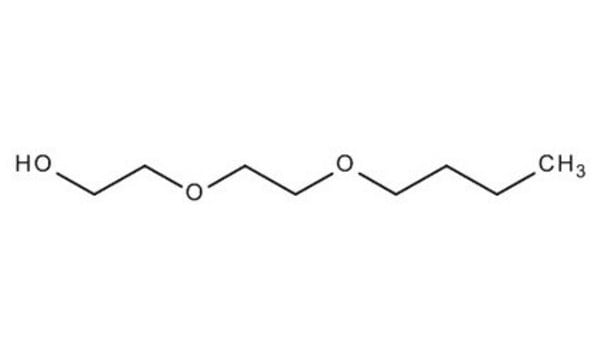579963
Diethylene glycol butyl ether
≥99%
Synonyme(s) :
Butyl CARBITOL™, 2-(2-Butoxyethoxy)ethanol, BDG, Butyldiglycol
About This Item
Produits recommandés
Densité de vapeur
5.6 (vs air)
Pression de vapeur
30 mmHg ( 130 °C)
Pureté
≥99%
Forme
liquid
Température d'inflammation spontanée
400 °F
Limite d'explosivité
6.2 %
Indice de réfraction
n20/D 1.432 (lit.)
pH
7
Point d'ébullition
231 °C (lit.)
Pf
−68 °C (lit.)
Densité
0.967 g/mL at 25 °C (lit.)
Application(s)
hematology
Chaîne SMILES
CCCCOCCOCCO
InChI
1S/C8H18O3/c1-2-3-5-10-7-8-11-6-4-9/h9H,2-8H2,1H3
Clé InChI
OAYXUHPQHDHDDZ-UHFFFAOYSA-N
Vous recherchez des produits similaires ? Visite Guide de comparaison des produits
Description générale
Application
- Factors Affecting the Adsorption of Per- and Polyfluoroalkyl Substances (PFAS) by Colloidal Activated Carbon.: This study investigates the adsorption characteristics of PFAS by colloidal activated carbon, with a specific focus on the role of various solvents including diethylene glycol butyl ether. The research highlights the solvent′s effectiveness in enhancing adsorption efficiency (Hakimabadi et al., 2023).
- First Stage of the Development of an Eco-Friendly Detergent Formulation for Efficient Removal of Carbonized Soil.: This research explores the formulation of eco-friendly detergents, demonstrating the use of diethylene glycol butyl ether as a key solvent for effective soil removal. The study underscores its potential in creating sustainable cleaning products (Fernandes et al., 2022).
Informations légales
Mention d'avertissement
Warning
Mentions de danger
Conseils de prudence
Classification des risques
Eye Irrit. 2
Code de la classe de stockage
10 - Combustible liquids
Classe de danger pour l'eau (WGK)
WGK 1
Point d'éclair (°F)
210.2 °F - closed cup
Point d'éclair (°C)
99 °C - closed cup
Équipement de protection individuelle
Eyeshields, Gloves, type ABEK (EN14387) respirator filter
Certificats d'analyse (COA)
Recherchez un Certificats d'analyse (COA) en saisissant le numéro de lot du produit. Les numéros de lot figurent sur l'étiquette du produit après les mots "Lot" ou "Batch".
Déjà en possession de ce produit ?
Retrouvez la documentation relative aux produits que vous avez récemment achetés dans la Bibliothèque de documents.
Les clients ont également consulté
Notre équipe de scientifiques dispose d'une expérience dans tous les secteurs de la recherche, notamment en sciences de la vie, science des matériaux, synthèse chimique, chromatographie, analyse et dans de nombreux autres domaines..
Contacter notre Service technique















